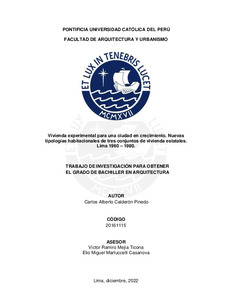| dc.contributor.advisor | Mejía Ticona, Víctor Ramiro | |
| dc.contributor.author | Calderón Pinedo, Carlos Alberto | |
| dc.date.accessioned | 2023-08-28T19:23:36Z | |
| dc.date.available | 2023-08-28T19:23:36Z | |
| dc.date.created | 2022 | |
| dc.date.issued | 2023-08-28 | |
| dc.identifier.uri | http://hdl.handle.net/20.500.12404/25794 | |
| dc.description.abstract | La vivienda ha sido la principal tipología que ha impulsado la mayoría de las políticas
urbanas a lo largo del siglo XX en el Perú, siendo la capital, la que más ha sido participe
de su evolución con diversas aproximaciones estatales en búsqueda de satisfacer el
creciente y cada vez más insostenible déficit habitacional. De esta forma, las décadas
de 1960 y 1970 fueron etapas de gran experimentación y construcción local de nuevas
formas de habitar, en las que no solo se trató de incorporar las dinámicas de las
barriadas, como la autoconstrucción , al diseño proyectual; sino que también se innovo
en estrategias respecto a formas de agrupación, materialidad y tecnología constructiva
de la vivienda social , dentro de una época donde los proyectos habitacionales reflejaron
una época de intenso debate y cambio de paradigmas sobre el quehacer arquitectónico
y su mirada hacia el rol con los habitantes. | es_ES |
| dc.description.abstract | Housing has been the main typology that has driven most urban policies throughout the twentieth century in Peru, with the capital being the one that has participated the most in its evolution with various state approaches in search of satisfying the growing and increasingly unsustainable housing deficit. In the way, the 1960s and 1970s were stages of great experimentation and local construction of new ways of living, in which the not only tried to incorporate the dynamics of the slums, such as self – construction, to the project design; but it also innovated in strategies regarding forms of grouping, materiality and constructive technology of social housing, within a time where housing projects reflected a time of intense debate and paradigm shift on architectural work and its gaze towards the role with the inhabitants. | es_ES |
| dc.language.iso | spa | es_ES |
| dc.publisher | Pontificia Universidad Católica del Perú | es_ES |
| dc.rights | info:eu-repo/semantics/openAccess | es_ES |
| dc.rights.uri | http://creativecommons.org/licenses/by-sa/2.5/pe/ | * |
| dc.subject | Arquitectura doméstica--Perú--Lima | es_ES |
| dc.subject | Vivienda de bajo costo--Perú--Lima | es_ES |
| dc.subject | Política habitacional--Perú | es_ES |
| dc.subject | Desarrollo urbano--Perú--Lima | es_ES |
| dc.title | Vivienda experimental para una ciudad en crecimiento. Nuevas tipologías habitacionales de tres conjuntos de vivienda estatales. Lima 1960 – 1980 | es_ES |
| dc.type | info:eu-repo/semantics/bachelorThesis | es_ES |
| thesis.degree.name | Bachiller en Arquitectura | es_ES |
| thesis.degree.name | Bachiller en Arquitectura | es_ES |
| thesis.degree.level | Bachillerato | es_ES |
| thesis.degree.grantor | Pontificia Universidad Católica del Perú. Facultad de Arquitectura | es_ES |
| thesis.degree.discipline | Arquitectura | es_ES |
| thesis.degree.discipline | Arquitectura | es_ES |
| renati.advisor.dni | 10556604 | |
| renati.advisor.orcid | https://orcid.org/0000-0003-0140-2274 | es_ES |
| renati.author.dni | 74762291 | |
| renati.discipline | 731026 | es_ES |
| renati.level | https://purl.org/pe-repo/renati/level#bachiller | es_ES |
| renati.type | https://purl.org/pe-repo/renati/type#trabajoDeInvestigacion | es_ES |
| dc.publisher.country | PE | es_ES |
| dc.subject.ocde | https://purl.org/pe-repo/ocde/ford#6.04.08 | es_ES |






